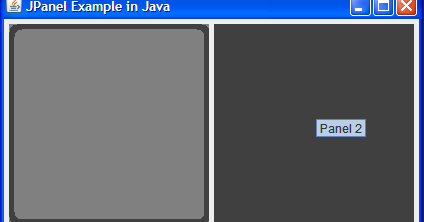

- Jpanel with flowlayout how to#
- Jpanel with flowlayout update#
- Jpanel with flowlayout software#
- Jpanel with flowlayout code#

Examples are addSelectionListener,ĪddMouseListener, addKeyboardListener, and more. Look for methods of theįorm addFooListener if you want to deal with the user doingįoo to your object. Other types of listeners can be registered.
Jpanel with flowlayout update#
The update button, so it will do what we want. Of the WeatherPanel has been registered the with NewCityListener (an inner class in MainFrame), and understand what itĪctionListeners registered with the button. In our weather program's combo box changes. We've written anĪctionListener for changing the city when the city selection When a JComboBox's selection changes, the ActionListeners Swing, many observer objects are called Listeners. How do you make them do anything? Swing uses the observerĭesign pattern to handle input and do the appropriate thing. Now you can put all sorts of widgets in a window. The other two JPanels that we subdivided in the first step will also have FlowLayout. Below that is a JPanel, which is called graphicsPanel, will use a FlowLayout to arrange the Therometer and Clouds side by side in a row. JPanel that contains information about the city and local time. The displayPanel has been divided into to three regions. Each JPanel will have its own layout, which will be described next. Below it, two more JPanels will be stacked. The top box will be a WeatherPanel which is a subclass of JPanel that has been defined. Here, three boxes have been created and stacked vertically. BoxLayout lets you stack one component on top of another (or arrange them side by side, in rows). Access it using the getContentPane() method BoxLayout and FlowLayout make sense here. Make a simple sketch of how we wouldįirst, divide the drawing into regions. Sun also has a Visual Guide to Layout Managers that can be very helpful when selecting layouts.ĭrawing the GUI.
Jpanel with flowlayout how to#
GridBagLayout, and you can find out how to use them in Sun's Useful layouts such as BorderLayout, GridLayout and In this section, we'll use BoxLayout and FlowLayout. Recursively divide the rest of the regions until you haveĮither a single component, or a simple panel of components. You should begin by dividing the application into After you've drawn a picture of what you want your user interface to look like, you'll need to figure out how to layout its components using the Swing LayoutManagers. The first step in GUI creation is design. Putting the finishing touches on a simple GUI application that reports In this section, you will get some hands-on experience with Swing by
Jpanel with flowlayout code#
We provide you with some sample code and appendix of commonly used Swing classes. Please be warned however that this section provides only a very brief You will often need to import both Swing and awtĬlasses in your code. Pane, or to a nested series of panels which then getĮach component arranges its children based on a layout manager. User interfaces can be created by adding components to a window's Property, and don't actually expect to have anything added to them. However, many components have this inheritance as a vestigial Most of Swing's classes are AWT Containers - technically, you canĪdd any component to any other component. All components in Swing are JComponents, which can be added to windows like JFrames or JDialogs. The Swing library is built on top of the Java Abstract Widget Toolkit (AWT), an older, platform dependent GUI toolkit. Labels and then we'll show you how to put together a simple GUI application that First, we'll go over how to make basic components, like a windows and text For this section, we will focus on the design and implementation Applications built in Swing look roughly the same on all platforms.Ĭreating a Graphical User Interface (GUI) involves significantĭesign. It contains a set of customizable components for building user interfaces, like buttons and text fields, as well as an API for creating 2D graphics.

Swing is a platform independent graphical toolset for Java applications.
Jpanel with flowlayout software#
CSE 331 Software Design and Implementation Section 8 Java Swing


 0 kommentar(er)
0 kommentar(er)
